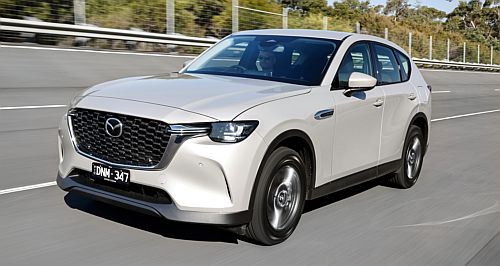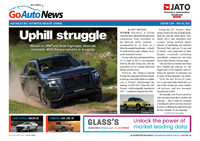Make / Model Search
News - MazdaMazda looks to value after premium experimentLower pricing for six-cylinder SUVs reflects a rejection of ‘Mazda Premium’ strategy2 Jun 2025 By TOM BAKER ANNOUNCED in the halcyon days predating the COVID-19 pandemic, the ‘Mazda Premium’ strategy sounded promising – Hiroshima’s view that it was time to push beyond its class-leading CX-5 and CX-9 models to a luxe platform supported by six-cylinder engines had more than a few pundits nodding along.
After a decade of continuous and substantial product improvement, and resulting sales growth not only in Australia (where it is an unusually big fish in a small pond) but elsewhere too, Mazda Corporation (MC) was flying high and production of the CX-60 six-cylinder SUV and various siblings was approved.
Whether development of the associated Large Product Group Platform (LPGP) was hindered by Japan’s pandemic restrictions, or simply rushed to deliver more years on sale before Europe’s Euro 7 was set to tighten CO2 and particulate emissions limits even further, we may never know.
In any case, the CX-60 launched in Australia in 2023 with a lukewarm reception for its harsh transmission and ride quality, but also its pricing – at $59,800-$87,252 plus on-road costs, it was quite good value against the Lexus NX, Volvo XC60, Audi Q5 and BMW X3 but it did not hit sales expectations.
Prices of better-known Mazdas had crept up considerably in Australia since ‘Mazda Premium’ came into the fold in 2018-2019 with only light grumbling, but the release of the first in the brand’s new line of four ambitiously positioned SUVs proved to be a bridge too far for Australian customers.
Mazda kept its foot down on the CX-60’s pricing while revising the suspension and eight-speed auto, but cracks in Mazda Australia’s confidence in the premium price strategy started to show when its stretched CX-80 sibling launched in 2024.
The decision by MC to discontinue its affordable four-cylinder three-row SUVs, the CX-8 (latterly $42,810-$72,160 + ORC) and CX-9 ($47,600-$74,400 + ORC) is understood to have triggered worries about retaining repeat business if the CX-80 was too expensive.
As a result, the CX-80 launched with a CX-60-busting $55,200-$76,200 + ORC price bracket for six-cylinder petrol and diesel versions, while plug-in hybrids (PHEVs) range from $75K-$87K. Then, in October, the more niche CX-70 widebody five-seater launched at $75K-$85K.
Mazda had already launched the wider (and better-received) CX-90 in Australia with pricing between $75K-$92K, but relatively slow sales of the flagship crossover triggered an April decision to slash costs by up to $7800, to $68,800-$86,800 + ORC, with no changes in equipment.
In May, it was finally the CX-60’s turn to receive range-wide price cuts of up to $7560, while a new ‘Pure’ base trim was introduced to bring the model’s entry price to $53,990 driveaway while even the priciest Azami grade now starts at $68,440 + ORC, with PHEVs priced from $63K-$81K.
“Where we have adjusted (pricing to) is where we have pretty much been transacting from early on,” Mazda Australia managing director Vinesh Bhindi told media.
“We have been going through a squeeze on family budgets for the last two years … we are reacting to where the market is,” Mr Bhindi said.
The resulting changes to the CX-60’s positioning sees the $50K-$81K upper-midsize SUV sit closer to high-spec versions of the CX-5 ($36,740-55,150 + ORC) than an Audi Q5 ($73,400-$113,984 + ORC) or BMW X3 ($86,100-$128,900 + ORC).
How long Mazda will be able to hold the current pricing of petrol and diesel versions of its SUV is unclear, however, with Mr Bhindi telling GoAuto that the brand will need to consider increasing prices once again to incorporate the impact of penalties under Australia’s NVES emissions laws.
Still – for the time being – Mazda is not finished with the hatchet.
It might have stepped down from ‘Mazda Premium’ pricing in order to meet the market’s expectations, but while the CX-60 platform was designed to carry six cylinders, Mazda Australia will also introduce a cheaper, non-hybrid, four-cylinder powertrain for the first time.
With a retail price of around $49,000 + ORC, the CX-60 engine line-up will expand from three to four. The new powertrain is understood to be the 138kW/250Nm 2.5-litre non-turbo four-cylinder seen in various other Mazda models (including the CX-5).
The four is expected to be an addition rather than a replacement to any of the current offers, which include a 209kW/450Nm 3.3-litre turbo petrol six, a 187kW/550Nm 3.3-litre turbo diesel six, and a 241kW/500Nm 2.5-litre PHEV.
At this stage, it is not known whether the CX-80 will also gain the entry-level four-cylinder engine in order to bring its starting price closer to $50,000.
“This addition will not only further expand our CX-60 offering but importantly continue to offer good value in the segment while meeting our consumers’ motoring needs,” Mr Bhindi said.  Read more26th of May 2025  Mazda 6e, CX-6e under review for AustraliaMazda 6e, CX-6e under review for Australia26th of May 2025  Mazda Australia gently pursuing rental, fleet salesGovernment, corporate and rental sales in Mazda’s sights, but resale is a factor |
Click to shareMazda articlesResearch Mazda Motor industry news |











Facebook Twitter Instagram